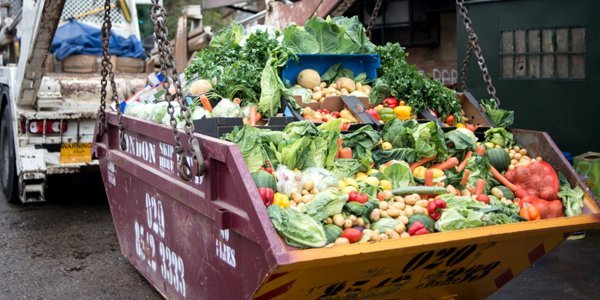There is a good chance there are fresh vegetables in
your refrigerator that will end up in the garbage instead of on your dinner
plate.
Not that anyone goes to the grocery store with the
intention of later throwing the food in the trash, but we all do it more often
than we probably realize. Ruth Litchfield, a professor of food science and
human nutrition at Iowa State University, says we waste about 20 pounds of food
each month. And that is per person.
"It's a huge problem," Litchfield said.
"When you think that 40 percent of the food produced in the U.S. goes to
waste, that is just irresponsible."
There are several reasons why so much of our food
ends up in the trash and eventually a landfill, which all relate to our
mentality about food. Litchfield says we need to move past the idea that more
is better. Whether it's purchasing more than what we need at the grocery store
or consuming large portions at a restaurant, our habits feed our tendency to
waste.
According to a 2012 Business for Social
Responsibility study on food waste, 44 percent of food going into the landfill
comes from the home, followed by 33 percent from the food service industry. To
do its part, the food service industry is employing a variety of initiatives,
said Susan Arendt, a professor of hospitality management at Iowa State.
Donating food to shelters or soup kitchens, incorporating leftover foods into
other menu items -- for example, using unserved green beans for vegetable soup
the next day -- and collaborating with farmers to feed unused food to farm
animals are just a few examples.
"Some restaurants are also training servers to
ask customers what they don't want with their meal. For example, instead of
bringing both butter and oil with bread, they're asking the customer which one
they prefer, rather than letting one go unused and have to be thrown out,"
Arendt said.
How
to limit your waste
Consumers can take similar steps at home to limit
waste and ultimately save money, Litchfield said. She recommends:
·
Meal planning for the week. There are
several benefits to making a weekly menu, not just cutting waste. If you know
you're going to be at a ball game or other activities during the week, cut back
on what you're buying at the store, Litchfield said. Make meals using frozen or
canned vegetables and other non-perishable items that you can use the following
week, if plans change.
·
Find an alternate use for produce.
Consider freezing or donating fresh produce that you're not going to eat before
it starts to wilt or rot. Cut and package the fruits and veggies so that
they're easy to pull out of the freezer and add to a smoothie or casserole.
· Composting. Some communities offer
composting programs, but Litchfield says it's relatively easy to do your own
composting at home. Food converted to compost is waste diverted from the
landfill, which contributes to greenhouse gas emissions.
·
Understand sell by dates. Litchfield
says we throw away 160 billion pounds of food that is fine to eat because of
confusion over "sell by" or "best by" labels. The date that
follows has nothing to do with the safety of the food, it's related to quality,
she said. Infant formula is the only product in the U.S. required to have an
expiration date. A provision in the proposed Food Recovery Act of 2015 would
standardize the language to reduce confusion.
Finding
ways to make an impact
When discussing food waste in class, Arendt breaks
it into two categories for students. There is product waste, such as eggshells
or coffee grounds, and service waste or food that is served and not eaten. She
says product waste is often unavoidable, although some items are good for
compost, while with service waste there are several opportunities to make an
impact.
For example, Arendt and a colleague conducted a milk
waste study in elementary schools. By implementing simple changes, schools
reduced the amount of milk waste. One school noticed students were throwing
away unopened cartons of milk, and created a "share table" for
students to leave unopened milk for other students to drink. She said another
school limited technology in the lunchroom so students focused on eating, and
not working or playing on their computers.
Portion control is another step the foodservice
industry is taking, but health-conscious consumers are more often the
motivating factor. Still, this can help with waste.
"Many restaurants are offering a half-portion
size and a regular-portion size. Yes, customers want to receive 'value,' but it
also depends on the type of customer," Arendt said. "Customers who
are more health conscious are open to smaller portion sizes."
Policy
that packs a punch
In 2015, the U.S. Department of Agriculture set a
national goal to reduce food loss and waste by 50 percent by 2030. Litchfield
is doubtful that many consumers are aware of this goal or are making an effort
to do their part. She says it is going to take policy, similar to seatbelt laws
or tobacco taxes, to motivate people to make change.
"If you look at when people really started
using seatbelts, it was when there was potential for a fine," Litchfield
said. "In some communities you are charged for garbage service based on
pounds or number of cans. If you were charged based on the amount of food waste
leaving the home, it might change habits."
Another contributing factor is the cost of food.
Litchfield is not advocating for higher prices at the grocery store, but she
says food in the U.S. is cheap compared to other countries. If it were more
expensive people would be less likely to overconsume, and be smarter about
their purchases so food is not going to waste.
Source:
Iowa State University
Find more information online at: http://www.foodwastealliance.org/wp-content/uploads/2013/06/FWRA_BSR_Tier1_FINAL.pdf

